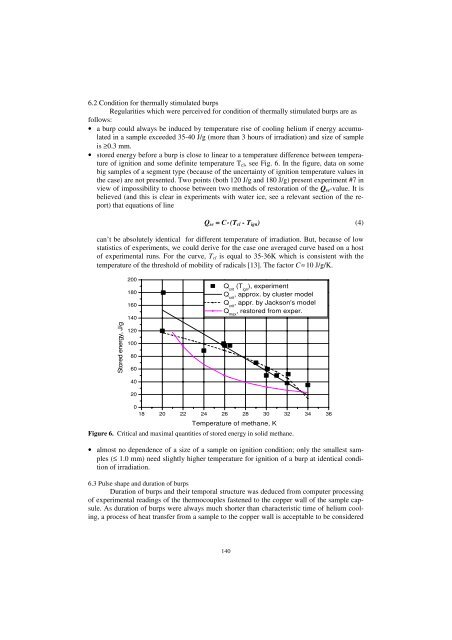Druck-Materie 20b.qxd - JUWEL - Forschungszentrum Jülich
Druck-Materie 20b.qxd - JUWEL - Forschungszentrum Jülich
Druck-Materie 20b.qxd - JUWEL - Forschungszentrum Jülich
You also want an ePaper? Increase the reach of your titles
YUMPU automatically turns print PDFs into web optimized ePapers that Google loves.
6.2 Condition for thermally stimulated burps<br />
Regularities which were perceived for condition of thermally stimulated burps are as<br />
follows:<br />
• a burp could always be induced by temperature rise of cooling helium if energy accumulated<br />
in a sample exceeded 35-40 J/g (more than 3 hours of irradiation) and size of sample<br />
is ≥0.3 mm.<br />
• stored energy before a burp is close to linear to a temperature difference between temperature<br />
of ignition and some definite temperature Tcl, see Fig. 6. In the figure, data on some<br />
big samples of a segment type (because of the uncertainty of ignition temperature values in<br />
the case) are not presented. Two points (both 120 J/g and 180 J/g) present experiment #7 in<br />
view of impossibility to choose between two methods of restoration of the Qse-value. It is<br />
believed (and this is clear in experiments with water ice, see a relevant section of the report)<br />
that equations of line<br />
Qse = C⋅⋅⋅⋅ (Tcl - Tign) (4)<br />
can’t be absolutely identical for different temperature of irradiation. But, because of low<br />
statistics of experiments, we could derive for the case one averaged curve based on a host<br />
of experimental runs. For the curve, Tcl is equal to 35-36K which is consistent with the<br />
temperature of the threshold of mobility of radicals [13]. The factor C≈ 10 J/g/K.<br />
Stored energy, J/g<br />
200<br />
180<br />
160<br />
140<br />
120<br />
100<br />
80<br />
60<br />
40<br />
20<br />
Q crit (T ign ), experiment<br />
Q crit , approx. by cluster model<br />
Q crit , appr. by Jackson's model<br />
Q max , restored from exper.<br />
0<br />
18 20 22 24 26 28 30 32 34 36<br />
Temperature of methane, K<br />
Figure 6. Critical and maximal quantities of stored energy in solid methane.<br />
• almost no dependence of a size of a sample on ignition condition; only the smallest samples<br />
(≤ 1.0 mm) need slightly higher temperature for ignition of a burp at identical condition<br />
of irradiation.<br />
6.3 Pulse shape and duration of burps<br />
Duration of burps and their temporal structure was deduced from computer processing<br />
of experimental readings of the thermocouples fastened to the copper wall of the sample capsule.<br />
As duration of burps were always much shorter than characteristic time of helium cooling,<br />
a process of heat transfer from a sample to the copper wall is acceptable to be considered<br />
140

















